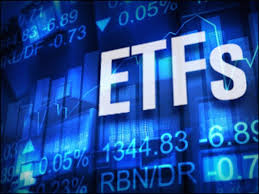If you’re looking to invest in several ETFs but don’t have the resources to do so, you can consider an all-in-one ETF to achieve similar results.
ETFs have already proved to be one of the best alternatives to stocks due to their low-cost and broader diversification.
But all-in-one ETFs take everything to the next level by allowing you to hold several underlying funds that suit your investment objective and risk tolerance.
In this article, we are going to look at the best all-in-one ETFs in Canada that are traded on the Toronto Stock Exchange.

Table of Contents
About All-in-One ETFs
For the sake of beginners, it’s essential to understand what all-in-one ETFs entail before proceeding to the main part of this article.
All-in-one ETFs simply refer to exchange-traded funds that hold underlying ETFs to achieve a given investment objective.
By holding several underlying ETFs in one portfolio, an all-in-one ETF saves you the cost and stress of investing in individual ETFs.
Another major advantage of all-in-one ETFs is that they provide easy access to broader diversification across different assets, markets, and sectors. This automatically reduces your investment risk.
As with a single ETF, all-in-one ETFs are also available in different asset classes. This means that their risk levels differ considerably.
Here we shall discuss the best all-in-one ETFs in Canada across conservative, balanced, growth, and equity asset classes.
Best Conservative All-in-One ETFs in Canada
If you have a low-risk tolerance or are approaching retirement, you should consider investing in an all-in-one ETF to achieve income and long-term capital appreciation. The following are the best conservative all-in-one ETFs to consider in Canada.
1. Vanguard Conservative ETF Portfolio (VCNS)
- Date of inception: January 25, 2018
- # of underlying holdings: 31,669
- Management fee: 0.22%
- MER: 0.24%
- Dividend yield: 2.60%
- Distribution frequency: Quarterly
- 1-year return: −11.07%
The Vanguard Conservative ETF Portfolio (VCNS) was launched in 2018 to provide moderate long-term capital growth and income.
To achieve its investment objective, VNCS allocates funds to equity and fixed-income securities. As of the time of writing, the ETF has the following allocations:
- Stocks = 39.88%
- Bonds= 60.09%
- Short-term reserves = 0.03%
VNCS ETF invests more in large-cap US and Canadian companies across financial, technology, industrials and other sectors.
With 31,669 underlying funds, VNCS manages to offer a -11.70 1-year return and + 2.54% return since inception (as of August 31, 2022).
2. BMO Conservative ETF (ZCON)
- Date of inception: February 15, 2019
- # of underlying holdings: 10
- Management fee: 0.18%
- MER: 0.20%
- Dividend yield: 2.90%
- Distribution frequency: Quarterly
- 1-year return: -10.94%
The BMO Conservative ETF (ZCON) was launched in 2019 to offer moderate long-term capital appreciation and income.
To achieve its investment objective, ZCON allocates most of its funds to global equity and fixed-income securities. The following are the current allocations of the ETF:
- Fixed income = 59.35%
- Stocks = 40.40%
- Cash and cash equivalents = 0.25%
As of August 31, 2022, ZCON had a 1-year return of -10.94% and a 2.91% return since inception.
3. iShares Core Conservative Balanced ETF Portfolio (XCNS)
- Date of inception: August 7, 2019
- # of underlying holdings: 20355
- Management fee: 0.18%
- MER: 0.20%
- Dividend yield: 2.22%
- Distribution frequency: Quarterly
- 1-year return: -11.13%
The iShares Core Conservative Balanced ETF Portfolio (XCNS) is another best conservative all-in-one ETF in Canada that was launched in 2019.
XCNS was also established to offer income and long-term capital appreciation by investing in fixed income and equity securities. Below are the current allocations of the ETF:
- Fixed income = 61.55%
- Equity = 38.67%
- Cash/derivatives = -0.22%
As of August 31, 2022, XCNS has provided an average 1-year return of -11.13% and 2.16% return since inception.
4. Horizons Conservative Tri ETF Portfolio (HCON)
- Date of inception: August 01, 2018
- # of underlying holdings: –
- Management fee: Varies
- MER: 0.15%
- Dividend yield: 0.09% (estimated)
- Distribution frequency: Annually
- 1-year return: -12.97%
The Horizons Conservative Tri ETF Portfolio (HCON) was launched in 2018 to provide investors with moderate long-term capital appreciation.
Unlike the above conservative all-in-one ETFs, HCON doesn’t have a fixed management fee and management expense ratio (MER)
HCON management fee varies and the MER is expected to be approximately 0.15%, lower than the MERs of most ETFs in Canada.
On the other hand, HCON’s estimated dividend yield of 0.09% is relatively lower than the dividend yields of most of the best all-in-one ETFs discussed here.
That being said, HCON has provided investors with a -12.97% 1-year return and 4.32% return since inception (as of August 31, 2022).
Best Balanced All-in-One ETFs in Canada
If you have an above-average risk level, you can’t go wrong with balanced all-in-one ETFs as they provide long-term capital growth and income.
Balanced all-in-one ETFs allocate funds across equity, fixed income and cash. This helps reduce your investment cost and risk.
That said, the following are the best-balanced all-in-one ETFs in Canada to consider.
5. Vanguard Balanced ETF Portfolio (VBAL)
- Date of inception: January 25, 2018
- # of underlying holdings: 31,669
- Management fee: 0.22%
- MER: 0.24%
- Dividend yield: 2.56%
- Distribution frequency: Quarterly
- 1-year return: −10.77%
VBAL is one of the popular all-in-one ETFs in Canada that was launched in 2018 to provide long-term capital growth and moderate income.
The ETF strives to allocate approximately 60% of funds on equity and approximately 40% to fixed-income securities. However, it has the following allocations as of the time of writing:
- Stocks = 59.88%
- Bonds = 40.08%
- Short-term reserves = 0.04%
That said, VBAL invests more funds in large-cap US and Canadian companies. With this, the ETF offered a −10.77% 1-year return and +3.70% return since inception (as of August 31, 2022).
6. BMO Balanced ETF (ZBAL)
- Date of inception: February 15, 2019
- # of underlying holdings: 10
- Management fee: 0.18%
- MER: 0.20%
- Dividend yield: 2.73%
- Distribution frequency: Quarterly
- 1-year return: -10.55%
ZBAL is the BMO equivalent to VBAL. The ETF seeks to provide moderate long-term capital growth and income through 10 underlying holdings.
As of the time of writing, ZBAL has the following assets allocation:
- Stock = 60.42%
- Fixed income = 39.50%
- Cash and cash equivalents = 0.09%
With a competitive dividend yield, ZBAL invests more in Canadian and US companies. As of August 31, 2022, it provided a -10.55% 1-year return and 4.56% return since inception.
7. iShares Core Balanced ETF Portfolio (XBAL)
- Date of inception: June 21, 2007
- # of underlying holdings: 20,355
- Management fee: 0.18%
- MER: 0.20%
- Dividend yield: 1.89%
- Distribution frequency: Quarterly
- 1-year return: -11.14%
XBAL is a balanced all-in-one ETF of iShares that is offered by BlackRock Canada. The ETF was also launched to provide long-term capital appreciation and income by investing in equity and fixed-income securities.
As of the time of writing, XBAL has the following assets allocation:
- Equity = 58.86%
- Fixed income = 41.15%
- Cash/derivatives = -0.02%
With over 20k underlying holdings, XBAL was able to offer -an 11.14% 1-year return and 4.54% return since inception (as of August 31, 2022).
8. Horizons Balanced Tri ETF Portfolio (HBAL)
- Date of inception: August 01, 2018
- # of underlying holdings: –
- Management fee: Varies
- MER: 0.16%
- Dividend yield: 0.06% (estimated)
- Distribution frequency: Annually
- 1-year return: -13.56%
The Horizons Balanced Tri ETF Portfolio (HBAL) also counts among the best balanced ETFs in Canada due to its low management expense ratio.
The ETF seeks to provide long-term capital appreciation by investing approximately 70% of its funds in equity and 30% in fixed-income securities.
What I like about HBAL is its low MER, which is approximately 0.16%. This is lower than what most all-in-one ETFs charge in Canada.
That being said, HBAL has provided -a 13.56% 1-year return and a 5.50% return since inception (as of August 31, 2022).
Best Growth All-in-One ETFs in Canada
Do you have low-medium risk tolerance? growth all-in-one ETFs could provide you with long-term capital appreciation without risking much. The following are the best growth all-in-one ETFs to consider in Canada.
9. Vanguard Growth ETF Portfolio (VGRO)
- Date of inception: January 25, 2018
- # of underlying holdings: 31,669
- Management fee: 0.22%
- MER: 0.24%
- Dividend yield: 2.14%
- Distribution frequency: Quarterly
- 1-year return: −10.61%
The Vanguard Growth ETF Portfolio (VGRO) is one of the popular ETFs in Canada that offer investors long-term capital using equity and fixed-income securities.
To achieve its investment objective, VGRO seeks to invest approximately 80% of its funds in equity and approximately 20% in fixed-income securities. The following current allocations show how the ETF strives to achieve the target:
- Stocks = 80.17%
- Bonds = 19.81%
- Short-term reserves = 0.02%
That said, VGRO invests more in large-cap US and Canadian companies. Currently, it has 31,669 underlying holdings split across global markets.
As of August 31, 2022, VGRO has offered 1-year of −10.61% and 4.81% return since inception.
10. BMO Growth ETF (ZGRO)
- Date of inception: February 15, 2019
- # of underlying holdings: 10
- Management fee: 0.18%
- MER: 0.20%
- Dividend yield: 2.58%
- Distribution frequency: Quarterly
- 1-year return: -10.12%
Launched in 2019, ZGRO also counts among the best ETFs in Canada due to its competitive dividend yields and returns.
With ZGRO, you will achieve long-term capital growth by having your funds invested in equity and fixed-income securities. The following are the current allocations of the ETF:
- Stocks = 80.47%
- Fixed income = 19.44%
- Cash and cash equivalents = 0.09%
As of August 31, 2022, ZGRO has provided investors with a -10.12% 1-year return and a 6.21% return since inception.
11. iShares Core Growth ETF Portfolio (XGRO)
- Date of inception: June 21, 2007
- # of underlying holdings: 20,355
- Management fee: 0.18%
- MER: 0.20%
- Dividend yield: 1.59%
- Distribution frequency: Quarterly
- 1-year return: -11.24%
The iShares Core Growth ETF Portfolio (XGRO) is one of the oldest all-in-one ETFs in Canada having been established in 2007.
With over 20k underlying holdings, the ETF seeks to provide long-term capital appreciation using equity fixed income securities. The following are the current allocations of the ETF:
- Equity = 79.02%
- Fixed income = 20.76%
- Cash/derivatives = 0.22%
That said, XGRO has provided a -11.24% as a 1-year return and a 3.58% return since inception (as of August 31, 2022).
12. Horizons Growth Tri ETF Portfolio (HGRO)
- Date of inception: September 13, 2019
- # of underlying holdings: –
- Management fee: Varies
- MER: 0.17%
- Dividend yield: 0.02% (estimated)
- Distribution frequency: Annually
- 1-year return: -14.13%
The last on our list of the best growth all-in-one ETFs in Canada is HGRO. This ETF invests primarily in equity and fixed-income securities to provide long-term capital growth.
HGRO distinguishes itself from other all-in-one ETFs in Canada by having a low management expense ratio (0.17% maximum).
On the other hand, HGRO has lower dividend yields and returns compared to the above-growth all-in-one ETFs.
Another problem I have with HGRO is that it seeks to invest approximately 99% of its funds in equity. Actualizing this allocation will make the ETF the riskiest growth all-in-one ETF on this compilation.
But because of its high allocation of equity, HGRO offered investors a competitive 8.40% return since its inception. This is higher than the returns of all the foregoing growth all-in-one ETFs
Best All-Equity ETFs in Canada
If you have a high-risk tolerance, an all-equity ETF will provide you with the maximum long-term capital growth because they invest primarily in equity. The following are the best all-equity ETFs in Canada to consider.
13. Vanguard All-Equity ETF Portfolio (VEQT)
- Date of inception: January 29, 2019
- # of underlying holdings: 13,579
- Management fee: 0.22%
- MER: 0.24%
- Dividend yield: 1.60%
- Distribution frequency: Annually
- 1-year return: −10.36%
The Vanguard All-Equity ETF Portfolio (VEQT) is one of the few all-equity ETFs in Canada that has over 13k underlying holdings.
VEQT invests primarily in equity securities with the aim of providing investors with long-term capital growth.
The ETF seeks to invest approximately 100% of its funds in equity. However, the following current allocations show a slight shift from the target allocation:
- Stocks = 99.96%
- Short-term reserves = 0.04%
VEQT invests more in large-cap US companies and has provided an 8.48% return to investors since inception (as of August 31, 2022.
14. BMO All-equity ETF Portfolio (ZEQT)
- Date of inception: January 17, 2022
- # of underlying holdings: 7
- Management fee: 0.18%
- MER: 0.20%
- Dividend yield: 2.43%
- Distribution frequency: Quarterly
- 1-year return: N/A
The BMO All-Equity ETF (ZEQT) is a newbie in the world of all-equity ETFs in Canada having been launched in January 2022.
ZEQT invests primarily in equity securities in order to provide investors with equity growth and long-term capital appreciation.
Unlike other all-equity ETFs, ZEQT currently beats its target allocation by investing 100.00% of funds in stocks.
With such strict allocation and the recency of the ETF (it hasn’t provided returns yet), you should expect a great deal of risk on ZEQT.
15. iShares All-Equity ETF Portfolio (XEQT)
- Date of inception: August 7, 2019
- # of underlying holdings: 9,379
- Management fee: 0.18%
- MER: 0.20%
- Dividend yield: 1.31%
- Distribution frequency: Quarterly
- 1-year return: -11.29
The last on our list of the best all-equity ETFs in Canada is XEQT. This ETF was launched in 2019 to provide investors with long-term capital growth.
To this end, XEQT invests primarily in equity securities through 9,379 underlying holdings. The following are the current allocations of the ETF:
- Equity = 99.64%
- Cash/derivatives = 0.36%
That being said, XEQT has provided a 1-year return of -11.29% and a 7.73% return since inception.
How to Choose the Best All-in-One ETF in Canada
One obvious thing to note from the above review is that all-in-one ETFs differ even within the same asset classes.
But whether you’re looking for a conservative, balanced, growth or equity all-in-one ETF, the selection process is the same.
First, it’s essential to understand your risk tolerance and financial situation when looking for the best all-in-one ETF in Canada. This means taking into consideration how much you’re willing to lose, your age, income and regular expenses.
After that, you want to consider your investment objective to ensure you invest in a portfolio that matches it.
Once you take the above factors into consideration, you can then compare different all-in-one ETFs under your risk tolerance level.
For example, if you’re going with a conservative all-in-one ETF, you should consider the following factors when narrowing your selection of the available conservative all-in-one ETFs.
- Assets allocation (this defines the risk level of the ETF)
- Underlying holdings (the higher, the better diversification)
- Management fees and MERs (the lower, the better)
- Dividend yields and returns (the higher, the better)
There you go! With this, you should be able to determine your overall best all-in-one ETF in Canada.
RELATED: Best Short-Term & Long-Term Investments in Canada
Over to You
There you have the best all-in-one ETFs in Canada. Which one are you going with? Please let me know in the comment section.
While all-in-one ETFs are low-cost and risk-saving alternatives to stocks and mutual funds, they can be counterproductive if you select the wrong one.
Selecting the right all-in-one ETF requires an understanding of your financial situation, risk tolerance and investment objective.
Whatever could be your situation, one of the above all-in-ones ETFs could be your best option. But if you’re not sure which to choose, kindly contact your financial advisor for direction.
Want to learn more about the Canadian investment industry? visit our Investing Archive.
If you have any related questions or concerns, kindly drop them in the comment section below or contact our team at [email protected].

